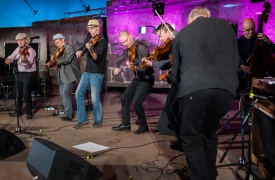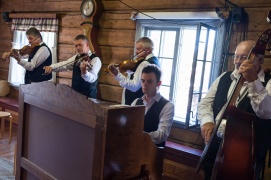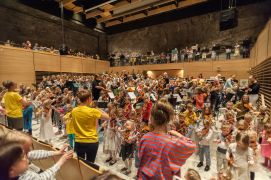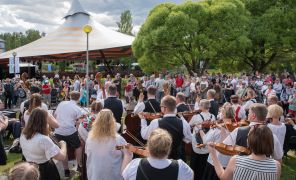Kaustinen fiddle playing
| Kaustinen fiddle playing | ||||
|---|---|---|---|---|
| In the national inventory | ||||
|
Practitioners and people who know the tradition well
Kaustinen, a municipality of 4,300 inhabitants in Central Ostrobothnia, is famous for its music tradition both in Finland and around the world. You could even say that, in the minds of many a Finn, Kaustinen equals folk music and folk music equals Kaustinen.
Hundreds of inhabitants of Kaustinen uphold a living music and dance tradition that features the fiddle as the key instrument. The tradition also extends to the neighbouring municipalities, particularly Veteli and Halsua.
The local folk music tradition has lived on from generation to generation, and it was previously primarily passed on by memory within the family. The area is home to several well-known families of musicians that comprise several generations of musicians extending all the way to present-day children.
With education and formal teaching, passing on the tradition has become more widespread, and the circle of skilled musicians has grown. Nowadays, many of the practitioners of the tradition have learnt to play in Näppäri activities for children (see below), among other places. The age distribution of the musicians covers all age groups evenly. All in all, there are several hundred people in the area who play folk music actively or less frequently, as well as a similar number of folk dance enthusiasts. Additionally, there is an enormous number of enthusiasts and professionals around the world who have grown up in the Kaustinen tradition and who practise folk music and other music genres.
Besides the fiddle tradition, the local kantele tradition is also significant, with dozens of active players. The Kaustisen Hääkuoro choir performs traditional music arranged for choirs, which is also included in the repertoires of many other local choirs. Additionally, people participate in the tradition by making and using performance costumes and other textiles related to the tradition, building instruments, participating in the organisation of events and collecting and recording historical information related to the tradition, among other things.
Practising of the tradition
Naturally, the tradition is practised first and foremost by playing music. In the past decades and centuries, this mainly involved wedding and dance music, while today it takes the form of ensembles that practise and perform music. Practitioners also play at home, either alone or together with others.
Almost every village in Kaustinen has its own ensemble, as do many families, and there are also other ensembles. All in all, there are 20–30 ensembles that perform every year.
The ensembles perform at local private and public events, such as weddings, funerals and other family celebrations, as well as public ceremonies and other places. Additionally, informal performances with changing configurations are arranged – or given spontaneously – both in homes and in public places such as the local restaurant. In addition to the vitality and multifaceted variety of the Kaustinen fiddle tradition, the tradition features stylistic and technical characteristics related to the playing style that have been passed on over an extended period of time and that are considered to give a distinctive and recognisable sound to the local music. These characteristics are related to bowing, legato, scales, ornaments and the chords used in the accompaniment, among other things. Variation also occurs between individual villages or musicians.
Playing together and learning by ear while playing with others continue to play an essential role in the passing on of these characteristics, even though most of the repertoire of traditional melodies from Kaustinen was already notated decades ago and almost all present-day musicians can read sheet music.
In addition to the playing of music, recreational folk dance is also very strong in Kaustinen. The dancers are accompanied by groups of young musicians from Kaustinen. Another tradition that continues to live on in Kaustinen is purppuri, a multi-part dance derived from court dances that was once played and danced at grand weddings. Its local variation deviates in many ways from the versions danced in other areas.
The music tradition and its significance are visible in many ways in the community’s everyday life, from the municipality’s coat of arms to public art and various names given to roads, locations, buildings and companies as well as culinary dishes, for example. This living and significant tradition also includes storytelling and reminiscing about musicians and their actions as part of everyday conversation.
The background and history of the tradition
The fiddle playing tradition of Western Finland, which has remained exceptionally dynamic in the Kaustinen region, dates back 250–300 years. Fiddle playing spread amongst peasants in Sweden and, little by little, on the Finnish coast of the Gulf of Bothnia in the 17th century, thanks to the prosperity and mobility of people and customs that resulted from tar trade, among other things. With the new instrument came new kinds of melodies, dances and wedding fashions.
The new fiddle music was enjoyed by young people, and the earliest mentions of it in Kaustinen are found in the church council records from the late 18th century, when musicians broke the parish’s prohibition against playing dance music on Sundays. The first new dance to be introduced was the polska, and it was followed later by the minuet, quadrille, contredanse française and different kinds of waltzes (hoppavalssi (‘jump waltz’) and siliavalssi (‘smooth waltz’)), among others.
Originally, the instruments, dances and, in part, even the melodies came from foreign lands and the upper classes, but talented musicians in the peasant community developed a distinctive playing style and their own ways of using the bow and chords and treating the melody and rhythm; their mastery required both talent and practice.
In peasant culture, the fiddle also became a wedding instrument, and as such it was the symbol of the whole great cultural change from a time of the runosong tradition and the kantele to an era of sleigh songs, broadside ballads and new kinds of dances.
The wedding tradition’s heyday in Western Finland took place in the 18th and 19th centuries. Grand weddings that could last for three days were accompanied by the best folk musicians, with several musicians playing at the same wedding through the multi-stage purppuri dances and ceremonies that involved hours of continuous music. As grand weddings were only held rarely, other dances were also arranged. The best folk musicians also played at larger dances that lasted for several days, while one player with more modest skills than wedding musicians was sufficient for smaller ‘corner dances’.
In the late 19th century, fiddles were joined first by pipe organs and later by harmoniums as accompaniment. Purppuripelimannit added the double bass to their configuration in the 1950s, and from then on the basic configuration of this folk music ensemble from Kaustinen has comprised fiddles and one or more harmoniums and double basses. Other common acoustic instruments, such as the guitar and the accordion, are also used to some extent. The area is also home to a strong kantele tradition, the melodies of which partly overlap with the fiddle repertoire. The kantele is also assumed to have influenced fiddle melodies, but the kantele is only rarely played together with fiddles, which is most likely at least partly due to reasons related to the instruments’ volumes.
Over the course of the 20th century, the tradition of holding grand weddings lasting for several days was overrun by modernisation, and a new kind of dance music gained ground. By the 1950s, there were only a few individual musicians left who still continued upholding the old-fashioned, personal playing style, but the tradition was successfully preserved with determined measures in Kaustinen, where the tradition was also otherwise strong. Weddings were replaced by events such as youth association soirées, folk music competitions, the constant playing of live music at the café of activist Santeri Isokangas, who promoted traditions, and the practising of purppuri dance at the Kaustinen Youth Association. Radio recordings of Kaustisen Purppuripelimannit brought Kaustinen into the awareness of the general public, until the popularity of Konsta Jylhä’s compositions and the Kaustinen Folk Music Festival gave an explosive start to a folk music renaissance in the late 1960s. Kaustinen became the centre of Finnish folk music. the centre of Finnish folk music.
The transmission of the tradition
The old-time Kaustinen style of playing has stayed alive, thanks primarily to the traditional method of learning by ear. Passing on the skill by memory, based on a master-apprentice model, has ensured the preservation of both the old style as well as a repertoire with hundreds of melodies.
A key factor in preserving the tradition is the determined work to record, maintain and develop it and to support and strengthen playing music as a hobby. As a result of this work and in support of it, strong and versatile organisations have been established around folk music in Kaustinen.
Today, the tradition is passed on by means of private and informal learning as well as instructor-led and organised learning. The Näppäri activities for children, which started in the 1980s, are a music teaching pedagogy based on the Kaustinen fiddle tradition in which the learners start from easy practice and make their way to traditional melodies from Kaustinen, among other things. Two generations of musicians continuing the Kaustinen fiddle tradition have already been raised with the Näppäri Method. The activities have also expanded nationwide and internationally. The key principles also include giving priority to playing together and ensuring that players of different ages and skill levels play together.
There are also instructor-led groups for adult folk musicians and purppuri enthusiasts. Roughly 200 children and young people participate in the instructor-led folk dance groups of the Kaustinen Youth Association, which are mostly accompanied by instructor-led ensembles. The repertoires of these ensembles largely comprise traditional melodies from Kaustinen.
The highlight of the year in Kaustinen is the Kaustinen Folk Music Festival founded in 1968, which is held in July. It is the largest folk music event in Finland and one of the most important in Europe. The event is attended by thousands of amateur and professional musicians from all over Finland and the world. The Kaustinen tradition is the heart of the festival’s identity in the eyes of the performers, the community and the audience alike, and every year groups from Kaustinen hold dozens of performances on each day of the festival. The motivation, visibility and feedback garnered by the event play a key role in the preservation of the tradition’s vitality.
The Finnish Folk Music Institute, which was established in 1974 and is located in Kaustinen, promotes folk music and folk dance at national level, but it has made a significant contribution to the preservation of the vitality of the local tradition through research, recording, archiving and publications, among other things. The Finnish Folk Music Institute was accredited as an advisory expert organisation of the UNESCO Intergovernmental Committee for the Safeguarding of the Intangible Cultural Heritage in 2018, and its tasks emphasise communal activities aimed at safeguarding the vitality of intangible cultural heritage. Tallari, the only folk music ensemble in Finland to receive state aid, operates as part of the Finnish Folk Music Institute organisation, and it has also been cooperating with the field of folk music in Kaustinen throughout its existence.
An open and flexible approach to renewal and change has been a significant factor in the vitality of the Kaustinen fiddle tradition. One important factor in the renaissance of the whole folk music scene in Finland in the late 1960s was that Konsta Jylhä, Wiljami Niittykoski and others after them began to compose original pieces that were inspired by the tradition but broke its limits while being sensitive to its style. In recent decades, numerous musicians and ensembles have made their way out into the world from this area. They are well-versed in the tradition and create new things by relying on the area’s music tradition, some more and some less.
The future of the tradition
The future of the Kaustinen tradition seems strong. It is practised actively and in an organised manner, and there are enough enthusiasts in all age groups to ensure the continuity of the tradition, as well as its development and renewal, for the time being. The preservation and development of the tradition are supported by strong and diverse organisations that have developed around it. They cover the organisation, documentation and recording of the recreational activities, along with education, training and the organisation of events.
The Kaustinen fiddle tradition and the work done to keep it alive received a special mention at the 2015 Europa Nostra Awards for cultural heritage of the European Union. Kaustinen fiddle playing was chosen for inscription on the National Inventory of Living Heritage in 2018, and in spring 2020 Finland submitted a proposal to UNESCO on the inscription of Kaustinen fiddle playing on the Representative List of the Intangible Cultural Heritage of Humanity. A decision is expected on the matter at the end of 2021.
The communities behind the submission
Pro Kaustinen ry / Kaustisen kansanmusiikkijuhlat
Bibliography and links to external sources of information
Videos
UNESCO nomination video on Kaustinen fiddle playing 2020
Lindfors, Jukka 2006. Kaustinen oli takuuvarma pelimannipitäjä. Yle Elävä Arkisto. Commentary by Niilo Ihamäki in Kaustinen in 1957.
Lindfors, Jukka 2006. Konsta Jylhän parhaat. Yle Elävä Arkisto. Performances by Konsta Jylhä from 1964–1971.
Lindfors, Jukka 2006. Heikki Laitinen ja Kankaan pelimannit. Yle Elävä Arkisto. Performances by and an interview with Heikki Laitinen from 1979.
Näppärit 2015. Raaliaali. YouTube-video.
Websites
Introduction to Näppäri pedagogy on the Nordic Safeguarding Practices website
Litterature
Asplund, Anneli & al. 2006. Kansanmusiikki. Suomen musiikin historia. Helsinki: WSOY.
Helistö, Paavo 1997. Konsta Jylhän, pelimannin ja kansansäveltäjän tarina. Kaustinen: Kansanmusiikki-instituutti.
Huntus, Antti & Järvelä, Mauno 2014. Näppäripedagogiikka. Kaustinen: Kansanmusiikki-instituutti.
Määttälä, Viljo S. 2005. Kaustisella kivetkin soi. Kaustinen: Kansanmusiikki-instituutti.





